Raw Coffee Beans: Understanding the Difference Between Raw and Roasted Beans
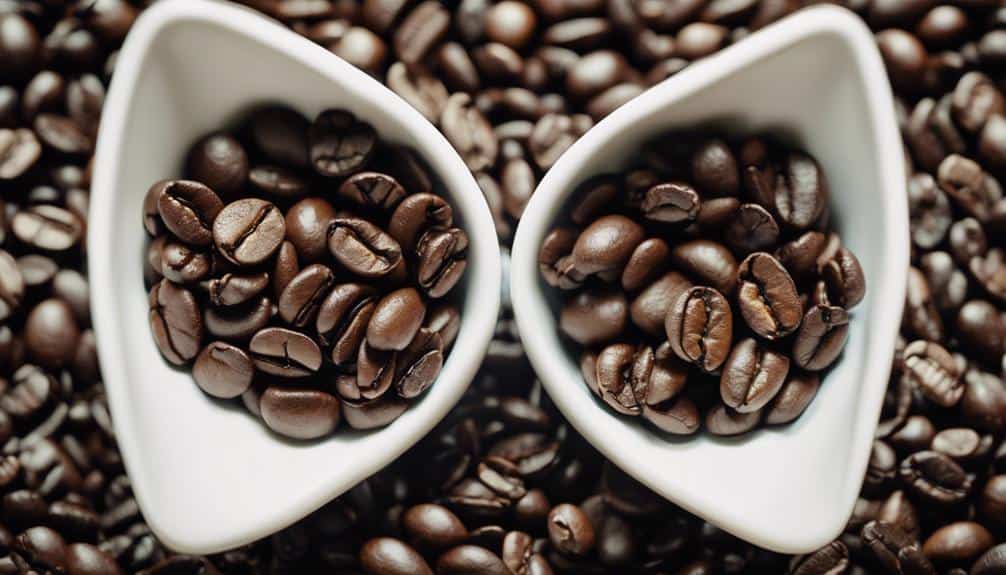
As someone who appreciates the intricate nuances of coffee, I've often found myself pondering the distinct characteristics that set raw coffee beans apart from their roasted counterparts. The transformation these beans undergo during the roasting process is a fascinating journey that reveals a myriad of flavors and aromas. But what secrets lie within the raw beans themselves, waiting to be discovered and explored? Understanding the fundamental disparities between raw and roasted coffee beans is just the beginning of unraveling the true essence of this beloved beverage.
Physical Characteristics of Raw Beans
While comparing raw coffee beans to their roasted counterparts, it becomes evident that the physical characteristics of raw beans are distinctive and essential in understanding the coffee bean's journey from its natural state to a flavorful beverage. Green coffee beans, in their raw state, exhibit a denser texture, unlike the softer consistency of roasted beans. This denser texture contributes to the beans' ability to retain their original size and hardness throughout the roasting process. Additionally, raw beans have higher moisture levels than their roasted counterparts, as roasting leads to a reduction in moisture content.
The aroma of raw coffee beans is characterized by its simplicity and grassiness, offering an invigorating and natural scent that differs significantly from the more complex and aromatic fragrance of roasted beans. Understanding these physical characteristics of raw beans is essential in appreciating the transformation they undergo during the roasting process, ultimately influencing the flavors and aromas present in the final brewed beverage.
Aroma and Flavor of Raw Beans
Raw coffee beans exhibit a straightforward grassy aroma and astringent flavor, distinct from the intricate profiles of roasted beans, highlighting the initial sensory experience before the transformative roasting process. The aroma of raw beans is often described as earthy and vegetal, lacking the depth and complexity that develops during roasting. Similarly, the flavor of raw beans tends to be more one-dimensional, with predominant grassy notes and a sharp, slightly bitter taste. In contrast, roasted beans offer a wide range of flavors, including acidity, sweetness, and bitterness, creating a more diverse and enjoyable sensory experience.
The simplicity of the aroma and flavor of raw beans sets the stage for the profound changes that occur during the roasting process. While raw beans may lack the complexity of their roasted counterparts, they provide a unique glimpse into the natural characteristics of the coffee before it undergoes the chemical transformations brought about by roasting. Understanding the distinct aroma and flavor of raw beans is essential for appreciating the full spectrum of coffee experiences.
Chemical Changes During Roasting
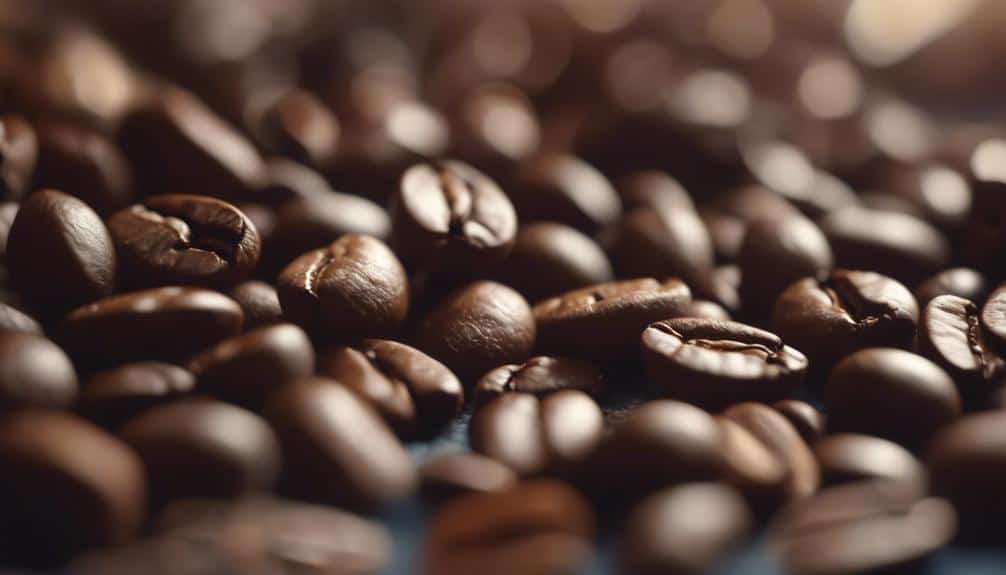
Roasting raw coffee beans induces significant chemical transformations that alter their physical properties and composition, leading to the development of distinct flavors and aromas. The roasting process is vital as it triggers a cascade of chemical reactions within the coffee beans.
One of the key reactions that occurs during roasting is the Maillard reaction, where amino acids and reducing sugars react to form new compounds responsible for the rich brown color and complex flavor profiles of roasted coffee. Additionally, the heat from roasting causes the beans to undergo both chemical and physical changes.
These changes include the breakdown of chlorogenic acids into quinic and caffeic acids, which contribute to the acidity and bitterness of the final brew. The aromatic cup of coffee we enjoy is a result of various volatile compounds developing during roasting, enhancing the overall sensory experience.
Understanding the intricate chemical changes that take place during roasting is essential for crafting the perfect cup of coffee.
Impact on Caffeine Content
The alteration of caffeine levels in coffee beans is influenced by the roasting process, with darker roasts typically containing slightly less caffeine. Roasting raw coffee beans leads to changes in their chemical composition, impacting the caffeine content.
Raw coffee beans inherently possess higher levels of caffeine compared to their roasted counterparts, as the roasting process causes the breakdown of caffeine molecules. Dark roasts, which undergo prolonged exposure to heat during roasting, may exhibit a lower caffeine content due to this extended roasting period.
Understanding the impact of roasting on caffeine content is crucial for individuals who prefer specific caffeine levels in their coffee brews. By selecting different roast levels, coffee enthusiasts can manipulate the caffeine content in their cup of coffee, tailoring it to their desired strength and flavor profile.
Experimenting with various roasts allows for a personalized coffee experience based on individual preferences for caffeine intake.
Brewing Techniques for Raw Beans

When brewing raw coffee beans, it's important to take into account techniques like soaking the beans and exploring cold brewing methods to extract distinct flavors.
Heat-free brewing techniques can be utilized to preserve the delicate nuances of raw beans.
Soaking Raw Coffee Beans
After soaking raw coffee beans for 12-24 hours, the softened beans are primed for grinding and extraction, enhancing the overall flavor profile of the brewed coffee. Experimenting with soaking times and water temperatures can help achieve desired flavor profiles when brewing raw beans.
Soaking raw beans in water for extended periods aids in softening the beans, leading to a smoother and more balanced taste compared to unsoaked beans. This process can also reduce acidity and improve the overall sensory experience of the brewed coffee.
- Soaking raw coffee beans for 12-24 hours enhances flavor profiles.
- Experimenting with soaking times and water temperatures is key to achieving desired tastes.
- Soaked raw beans offer a smoother, less acidic, and more balanced coffee experience.
Cold Brewing Methods
Utilizing the cold brewing method for raw coffee beans involves steeping coarsely ground beans in cold water for an extended duration, typically 12-24 hours. This slow extraction process enhances the flavors of raw coffee beans, resulting in a brew that's smooth and less acidic, showcasing the beans' natural characteristics.
Cold brewing raw beans produces a concentrate that can be diluted to create a revitalizing iced coffee with unique flavors. Unlike hot brewing methods, cold brewing reduces bitterness and acidity, offering a milder and more pleasant taste experience.
The simplicity and convenience of cold brewing make it a popular choice for highlighting the unique characteristics of raw coffee beans, appealing to those seeking a flavorful yet less intense coffee option.
Heat-Free Brewing Techniques
Engaging in heat-free brewing techniques for raw coffee beans offers a spectrum of innovative methods to extract and preserve the distinct flavors and characteristics inherent in the beans.
Key Heat-Free Brewing Techniques:
- Cold Brew: Steeping coffee grounds in cold water without heat for an extended period.
- Flash-Chilled Coffee: Rapidly cooling hot coffee over ice to maintain raw bean flavors.
- Toddy System: Immersion brewing method producing a smooth, low-acid coffee concentrate without heat.
Flavor Development in Roasting
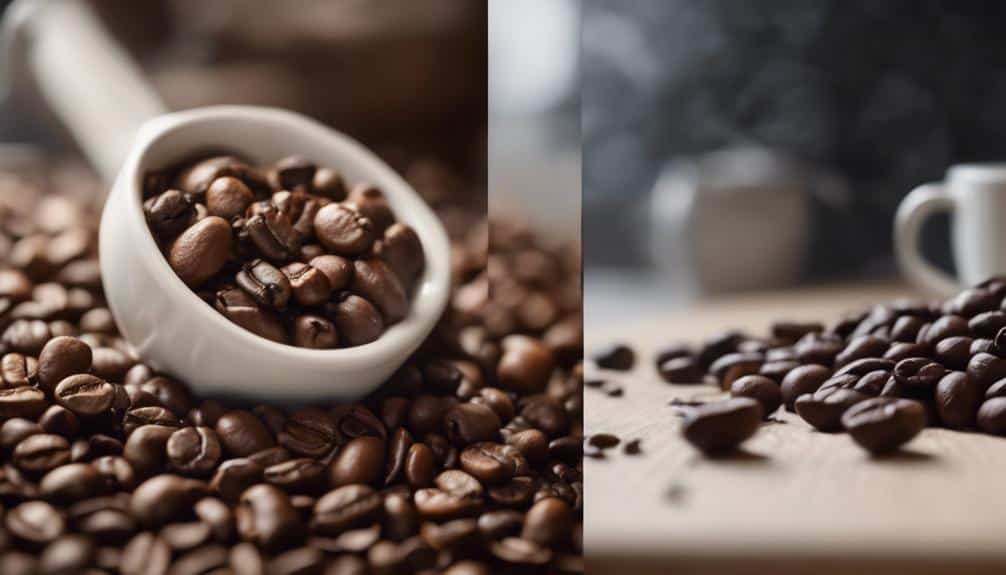
Roasting coffee beans enhances flavor development by breaking down sugars and creating aromatic compounds in the beans. The Maillard reaction, a chemical reaction between amino acids and reducing sugars, occurs during roasting and contributes importantly to the formation of complex flavor profiles in coffee. This reaction is responsible for the browning of the beans and the development of various flavor compounds that result in the rich and diverse flavors found in a brewed cup of coffee.
Different roasting levels play a vital role in determining the balance of acidity, sweetness, and bitterness in the final coffee brew. The desired flavor nuances and profiles can be achieved by carefully controlling the roasting temperature and time. This art of roasting coffee beans requires precision and expertise to bring out the unique characteristics of each bean variety and create a delightful sensory experience for coffee enthusiasts.
Health Benefits of Raw Vs. Roasted
Flavor development in roasting coffee beans has a notable impact on their health benefits, particularly when comparing raw beans to roasted beans.
Here are some key health differences between raw and roasted coffee beans:
- Chlorogenic Acid Levels: Raw coffee beans contain higher levels of chlorogenic acid than roasted beans. This antioxidant compound has been associated with potential benefits such as weight loss and maintaining a healthy BMI.
- Blood Pressure and Cardiovascular Health: Consumption of green, unroasted coffee beans may lead to lower blood pressure levels, contributing to improved cardiovascular health. Studies have shown that these effects can be seen in as little as six weeks.
- Cholesterol Levels and Skincare Benefits: Both raw and roasted coffee beans have been linked to lowering cholesterol levels and balancing blood sugar, supporting heart health. Additionally, unroasted coffee beans have shown promise in improving dry skin and enhancing skin hydration, offering potential skincare benefits when used in topical treatments.
Specialty Coffee Culture Influence
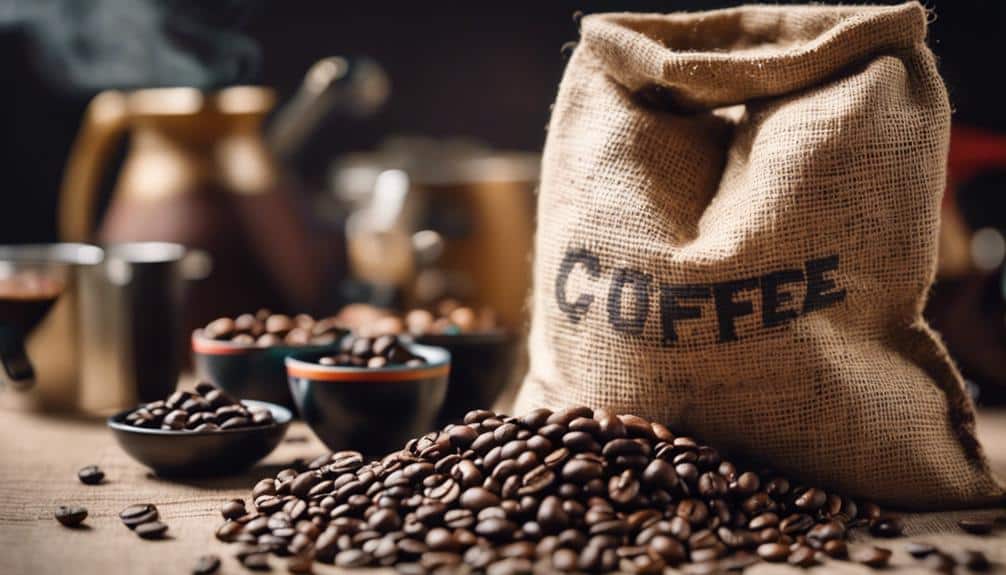
Specialty coffee culture plays a key role in the way we perceive and enjoy coffee, shaping trends and preferences in the industry. Understanding this influence is vital to appreciating the nuances of roasting techniques and flavor development.
Exploring how specialty coffee culture shapes roasting practices can lead to a deeper appreciation for the craft and diversity of raw coffee beans.
Coffee Culture Impact
Within the domain of coffee culture impact, the emphasis on unique origin-based flavor profiles and artisanal brewing techniques stands out prominently.
Key Points:
- Specialty coffee culture showcases distinct flavor profiles from various coffee-growing regions, enhancing the coffee experience.
- Artisanal brewing methods are integral to specialty coffee culture, elevating the preparation process and highlighting the nuances of different beans.
- Sustainability plays an essential role in specialty coffee culture, driving ethical practices that benefit both the environment and coffee-producing communities.
These factors collectively contribute to the rich tapestry of specialty coffee, where selective bean choices, meticulous brewing techniques, and a focus on sustainable practices converge to create a vibrant and diverse coffee culture.
Specialty Coffee Trends
In the world of specialty coffee trends, a growing emphasis on sustainability practices is reshaping the industry landscape. The specialty coffee culture focuses on unique flavor profiles of raw coffee beans, utilizing artisanal brewing methods to highlight the diverse offerings. Coffee cupping, a sensory evaluation technique, aids in selecting raw beans that align with desired flavor profiles for roasting. Sustainability plays a pivotal role in this movement, ensuring the longevity and quality of the industry. The specialty coffee sector thrives on showcasing the distinct characteristics of raw coffee beans, offering enthusiasts a wide range of flavors and experiences.
| Specialty Coffee Trends | |
|---|---|
| Unique Flavor Profiles | Artisanal Brewing |
| Sustainability | Coffee Cupping |
Influence on Roasting
Utilizing precise roasting techniques in the specialty coffee culture greatly impacts the final flavor profiles extracted from raw coffee beans.
Key Points:
- Roasting Process: Specialty coffee culture focuses on carefully controlled roasting methods to highlight the unique characteristics of raw coffee beans from different regions.
- Flavor Profiles: The roasting process plays a pivotal role in developing diverse flavor profiles, influenced by factors such as roasting temperature, time, and bean origin.
- Artisanal Brewing Techniques: Embracing artisanal brewing techniques allows for experimentation with roasting styles, leading to the creation of complex and refined flavors in roasted coffee beans.
Through a meticulous approach to roasting, the specialty coffee culture elevates the sensory experience by maximizing the full potential of raw coffee beans, resulting in a rich tapestry of flavors for coffee enthusiasts to savor.
Choosing Between Raw and Roasted
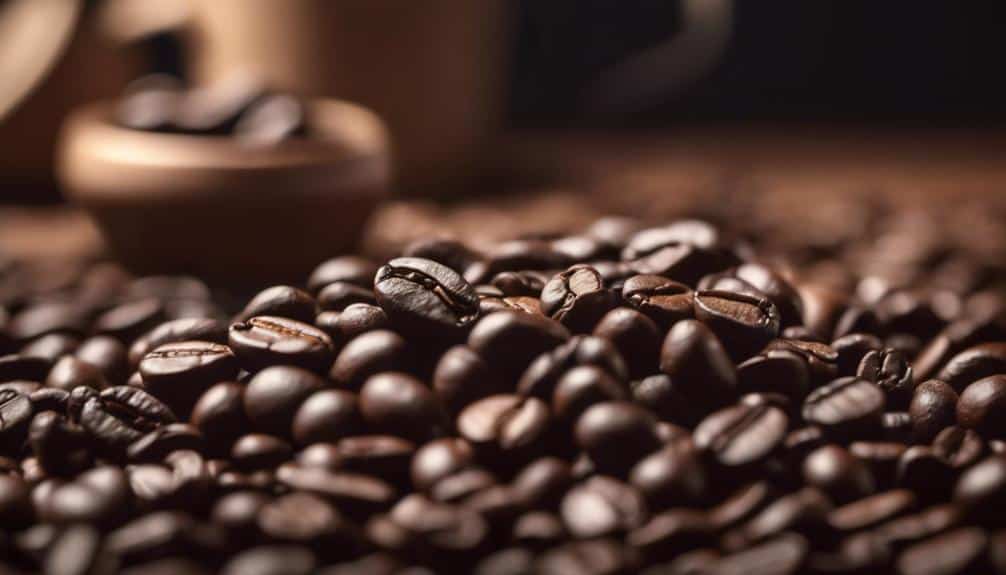
When deciding between raw and roasted coffee beans, consider the distinct flavor profiles and brewing characteristics each type offers.
Roasted coffee beans contain a complex mix of chemical compounds that produce rich, aromatic flavors with varying levels of acidity and sweetness. In contrast, raw coffee beans have a more grassy and astringent taste due to their lack of roasting.
The roast level also plays a significant role in caffeine levels, with darker roasts generally containing slightly less caffeine than lighter roasts due to the roasting process breaking down caffeine molecules.
Roasted beans are suitable for a wide range of brewing methods, allowing the extraction of unique origin flavors that raw beans can't offer. Additionally, roasted beans exhibit visible oils on their surface, enhancing the overall richness and mouthfeel of the coffee, a feature absent in raw beans which remain dry.
Consider your preference for flavor complexity, caffeine content, brewing method, and mouthfeel when making your choice between raw and roasted coffee beans.
Conclusion
To summarize, understanding the differences between raw and roasted coffee beans is essential for achieving the desired flavor and aroma in your cup of coffee.
From the physical characteristics and aroma of raw beans to the complex chemical changes during roasting, each stage plays a significant role in developing the final product.
Whether you prefer the simplicity of raw beans or the complexity of roasted beans, knowing how each stage influences the end result is key to crafting the perfect brew.





